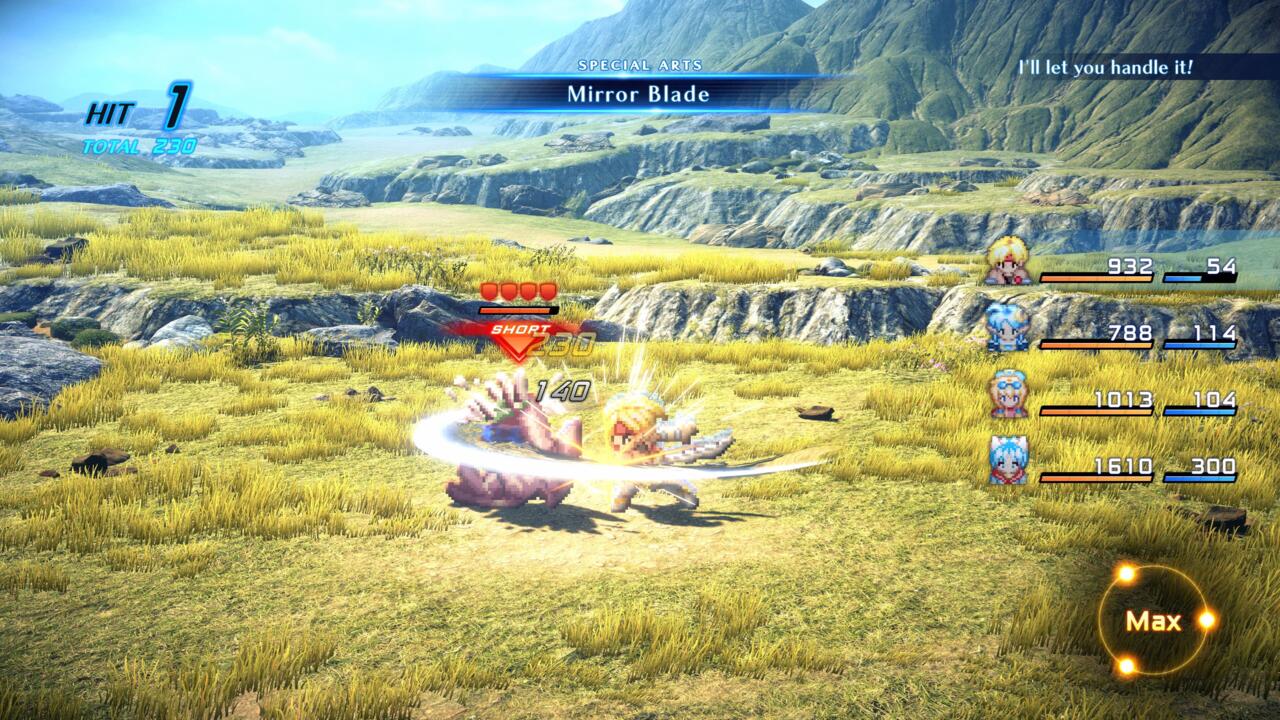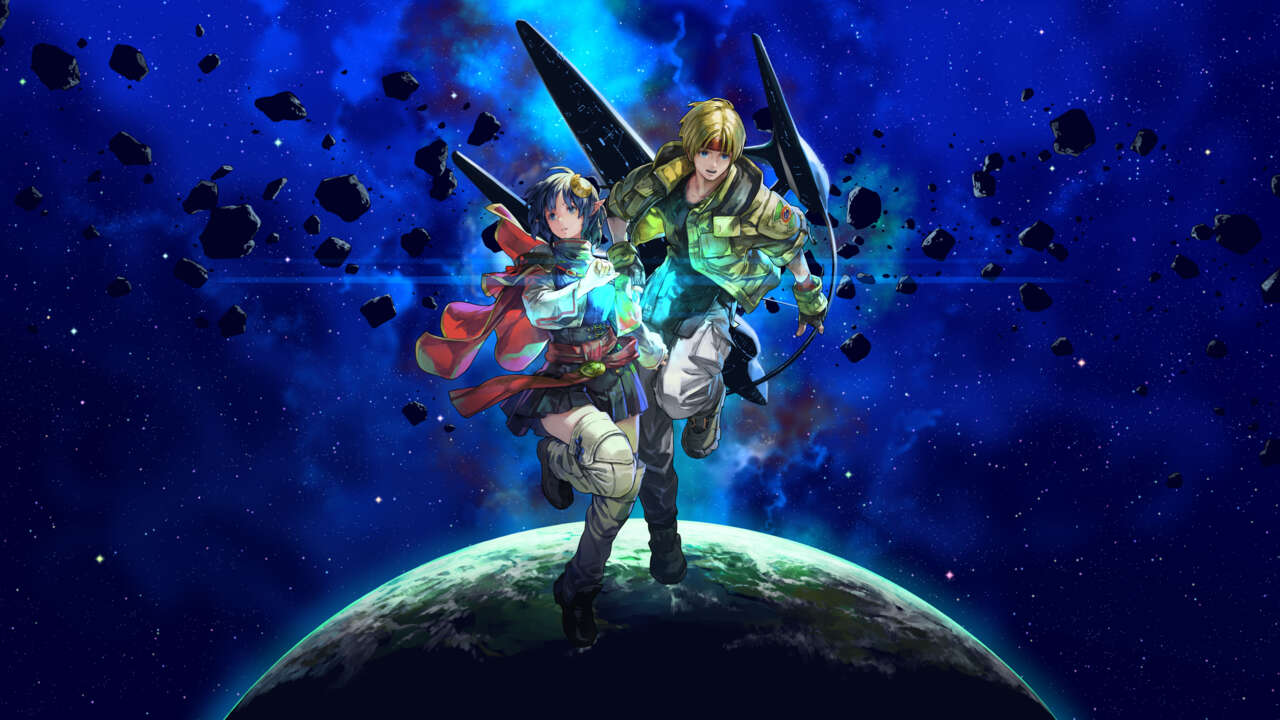The Star Ocean franchise has been an underappreciated one within the Japanese RPG genre. Despite being around for more than 25 years, it’s never had the breakout success that elevated it to new heights, as something like Persona or Tales have had in more recent years. Many longtime fans consider 1999’s Star Ocean: The Second Story to be the best entry, and now Square Enix has remade it for modern consoles. Star Ocean: The Second Story R is a remake that manages to not only have the retro feel of its older PS1 and PSP incarnations, but also make it feel fresh with new battle mechanics, as well as audio and visuals updates. It may not be the big break that’ll finally make the Star Ocean franchise explode in popularity, but it’s a fine Japanese RPG on its own terms.
The Second Story’s plot follows an energetic young man named Claude C. Kenny and a caring young girl named Rena Lanford. After disobeying his father’s orders and touching a malfunctioning piece of teleportation equipment, Claude accidentally lands on a backwater planet called Expel, runs into Rena, and has to protect her from a monster. These two characters are the core focus of the story, and their respective motivations and situations make for great plot drivers. In an effort to find a way to return home, Claude agrees with the local village to investigate the Sorcery Globe, a mysterious meteor-like object that crashed into Expel, causing the surrounding area to be infested with monsters. As he’s from a technologically advanced society, he thinks that the object could provide clues on how to get off of Expel. Rena, meanwhile, is an orphan and hopes to uncover more of her own past, as she is the only person on Expel to be blessed with natural healing powers.
While its story isn’t as complex as more modern Japanese RPGs such as Xenoblade Chronicles 3, its simplicity allows character relationships to shine. The juxtaposition between Claude’s technological upbringing, where flying in spaceships was an everyday occurance, and Rena’s more medieval background makes for an interesting dynamic between the two and the world around them–the villagers mistake him as some sort of prophetic figure because he takes the local monster down with a laser gun, which the villagers think is some sort of “sword of light” straight out of a fantasy novel.
Star Ocean: The Second Story has a total of 12 playable characters, including Claude and Rena. Of these, eight can be recruited in a single playthrough. Due to the variable nature of your final party, that means that many of the characters don’t have direct involvement with the plot. However, this is made up for with Private Actions, which are side conversations Claude and Rena can have with these characters throughout the game’s many cities. These add a lot of charm and are abundant since they change depending on your party composition. For example, having the young engineer, Precis F. Neumann, and the item inventor, Welch Vineyard, recruited in the same party unlocks a conversation where Welch learns a new attack skill to use in battle. The sheer number of possible party combinations adds to the immense replayability of the game. It also gives some value to characters that otherwise feel like bit parts in the main narrative.
The battle system retains its real-time action-based combat and up to four party members can be on screen at a time. It’s similar to Final Fantasy XVI in that you control one character in real-time with basic attacks and special skills while your other companions are controlled by the AI. The fights are exciting and dynamic, with particle effects flying as swords repeatedly clash with armor and magical spells conjure blades of wind and tsunamis to envelope the battlefield. Whether it’s Claude chucking fireballs out of his sword or Rena summoning giant stone orbs out of the sky, there’s not a dull moment during any fight.
Even though this remake still has its original battle system, smart changes were added to make it feel more modern. There are two new mechanics called the Break and Assault Action systems. Each enemy has a shield that dampens the damage you deal, and so it’s imperative that you use skills that prioritize breaking defenses rather than inflicting HP damage. Once the shield is broken, enemies are temporarily immobilized and you can wail on them. This system incentivizes you to switch up your attacks and keeps the approach varied, like Tales of Arise.
The Assault Action system takes characters not directly participating in battle and allows you to summon them to unleash support attacks. It’s a fantastic way to include inactive characters in a manner that makes them feel like they’re still contributing to fights. Additionally, by completing side quests, you can sometimes earn the ability to summon characters from other Star Ocean games, such as Laeticia from Star Ocean 6: The Divine Force and Edge from Star Ocean 4: The Last Hope. As a long time fan of this series, this mechanic was an excellent way to utilize nostalgia without feeling cheap. While calling on cameo characters seems strange from a narrative standpoint, they’re completely optional and you can choose to only summon characters from Second Story.
As you defeat enemies, you collect orbs to build up your Bonus GaugeBattle Bonus meter to grant passive bonuses, like increased attack power or more experience after battle, which helps keep you engaged from battle to battle. This mechanic was introduced in the third game in the series, Star Ocean: Till the End of Time. While it’s not a new mechanic to the series overall, it’s the first time Second Story has it, which is a welcome addition that makes this remake feel more in line with later entries.
Despite the exciting battle system, it’s held back by a flimsy dodge mechanic. Enemies glow red to indicate an incoming powerful attack. If you correctly time your dodge, you’ll zip behind the enemy and restore some of your MP, allowing you to unleash more skills. But the timing needed to pull off a successful dodge feels off and the window isn’t generous enough. Flubbing your dodge has disastrous consequences as not only does it leave you wide open to be massacred for a few seconds, it also resets your Bonus Gauge. The cons vastly outweigh the pros and I decided to just tank incoming hits from enemies instead of dodging. I could always heal my HP with an item, so it simply wasn’t worth potentially being ganged up on and dying while also losing my Bonus Gauge.
After a fight, battle points earned by characters can be distributed into stats, battle skills, and abilities to make them stronger. You can choose to focus on increasing Claude’s overall attacking power, or level up a certain battle skill so that it unleashes extra hits. For example, I maxed out Claude’s Sword Bomber skill, which increased the overall damage and number of fireballs launched. It’s a great way to tailor your own playstyle as I focused on Claude’s crowd control tactics–leveling up Sword Bomber effortlessly let me wipe out multiple enemies at once.
Another staple mechanic of the series, Item Creation, is back. It’s a relatively simple concept where you can combine different ingredients to create a variety of weapons, items, and gear. It’s not imperative to master Item Creation during a normal playthrough, but on higher difficulties and post-game content, it’s definitely useful. Being able to forge stronger equipment and create specific setups for harder battles goes a long way. It adds an entire new dimension to gameplay as I was able to engineer bombs that could momentarily stun bosses and prevent them using their strongest attacks. There were also instances during battle where I needed more potent healing, so some of the potions I made recovered up to 100% HP. These higher tier items weren’t typically found in regular shops, so it’s a great incentive to tinker around with Item Creation and discover new recipes and formulas.
Square Enix teamed up with GemDrops, which also developed Cogen: Sword of Rewind and Crystar, for Second Story R. The remake follows the trend of Square Enix’s 2.5D graphical games, which are characterized by their 2D pixel art character sprites with retro-styled 3D environments and movement. These games include Octopath Traveler 1 and 2, Triangle Strategy, and the Live a Live remake. However, Second Story R takes this art style a step further by keeping the 2D pixel art character sprites but using fully modern 3D environments and buildings. The backgrounds, foliage, and lighting look amazing to the point that it actually looks like the 2D characters are a bit out of place. It feels as if more polygonal character models like in the original Final Fantasy VII would be more appropriate.
This remake also includes full English and Japanese voice acting, and that adds to the overall prestige of this remake. The quality of voice acting has come an enormous way since the early to late 2000s, and Second Story R’s new voice cast is lightyears ahead of its previous iterations. The voices have much more range and emotion than ever before.
Additionally, Motoi Sakuraba’s newly arranged soundtrack for this game sounds immaculate. The franchise’s battle themes are grandiose with their gorgeous strings mixed with electrifying guitars, making them distinctly “Star Ocean.” Second Story R’s battle theme, “Stab the Sword of Justice,” doesn’t disappoint. The newly drawn 2D character art in the menu is incredible, too; the lines and colors look sharp and crisp. If you’re feeling extra nostalgic, you can switch between the new character art and the older ones from the PSP and PS1 days and have them displayed in the menu. This is a nice visual indicator of how much effort and care Square Enix and GemDrops put into this particular remake.
Another strength of Star Ocean: The Second Story R is its replayability. New Game Plus allows you to experience the story again, but has other perks such as carrying over your levels and equipment. Due to the variability of your final party, there are 99 different character endings depending on the relationship level between the characters in your party and how many Private Actions you’ve viewed. There are endings for each single character, as well as endings for each possible pair. Since you only have a total of eight party slots with 12 twelve possible characters, multiple playthroughs are needed to unlock every single one since different final party compositions are needed.

Trying to view all of these throughout multiple playthroughs isn’t for the faint of heart. Furthermore, you don’t even have to immediately get started on New Game Plus upon completing the game, either. The franchise’s signature post-game dungeon, Maze of Tribulations, returns and cooks up a beefy challenge for players who want to take on the hardest fights the game has to offer.
Star Ocean: The Second Story R strikes an ideal balance between staying faithful to the original game and updating it for modern times. The revamped art style and music make it more aesthetically pleasing while the use of 2D pixel character models adds a certain nostalgic charm. The battle system didn’t need a complete overhaul and the developers smartly added new features to make it feel more dynamic–the fights feel exhilarating and fun. Second Story R is jam-packed with content that will last any Japanese RPG fan satiated for hours on end.






